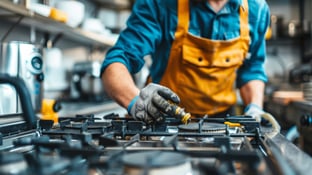Baology owner Judy Ni grew up surrounded by local ingredients. Most of the vegetables in her family’s kitchen – ingredients like water spinach, bitter melon, luffa, and garlic chives – came from her own backyard, with Ni’s parents, grandmothers, and aunts immersing her in how to use them.
“I was fortunate to grow up in a family that immigrated to the U.S. from a culture that values food and contributes a lot of meaning to it,” says Ni. “A lot of the vegetables, vegetables my parents had grown up with in Taiwan, just weren’t vegetables you could access in the northeast at the time.”
Food was central to Ni learning about her Taiwanese heritage. And eventually, despite some reluctance from her parents, it became central to her career.
While attending business school at New York University, Ni saw the farm-to-table dining scene in its dawn of explosion – and she dreamed about being a part of it. After graduating, she took her first restaurant job, starting as a hostess at a tavern in New Jersey and eventually working her way to become a captain at Blue Hill at Stone Barns.
Then, in 2017, with nearly 13 years of industry experience, Ni decided it was time to break out on her own, and in partnership with her husband Andy Tessier, Baology was born. The Philadelphia restaurant focuses on Taiwanese cuisine, with a mission to give back to the community by sourcing local ingredients, paying staff a fair wage, and, as Ni puts it, “getting better food into more bellies”.
We chatted with Ni to learn more about how those goals have shaped her business and the changes she’s made to stay afloat during these challenging past few years.
Since opening Baology, you’ve voiced a mission to source responsible ingredients. Can you share how that goal has shaped the business over the years?
Our goal is to support as many local farmers and local purveyors as possible. I don’t want to create the illusion that everything’s local because that’s just not possible. But we do buy all from local purveyors. For example, rice is not local. But we’re buying it from a local purveyor.
I grew up with very flavorful food. We weren’t shy about spices or ingredients that highlight unique flavors and textures, and that was something I wanted to bring out in the food at Baology. We do it through a lot of old-fashioned techniques, like pickling. But we also wanted to build a local ecosystem, understanding that if you buy local, and it takes less time from when it comes out of the ground to when it gets into your belly, it’s better and better nutritionally.
It’s also an investment and an understanding that you exist within a community. Restaurants are where people gather, exchange ideas, catch up on the gossip in the community. And I feel that there’s a responsibility if you’re taking dollars from this community, you’re also passing it through to other members of the community.
Can you share how you handle the added cost of sourcing locally, or how you think of that investment as a business owner?
I don’t know if I’ve done the best job with it. It’s a really complex idea to talk about because people love the idea of local, but people love the idea of really cheap food. I don’t think we understand the value of ingredients, the value of labor that goes into the entire food system.
When we were open to the public, we’d invest time to tell customers about the stories of the ingredients we’re excited about. I’d spend 10 minutes educating people about a specific rice. But you have to gauge people’s interest.
For such a long time, we’ve artificially held down wages, and I would argue good food, and we’re paying the long-term consequences of it. As a society, we’re more focused on acute issues than chronic issues. We’re reactive instead of preventative. We as Americans are enamored by food but we don’t value it.
So we try to balance this, and I’ll tell you, the market isn’t ready for the true cost of the food. And I worried about it this summer. We’re in downtown [Philadelphia], and no one is at the office. It’s crickets. And it’s a struggle.
Did you change anything throughout the pandemic, or even within the past six months, to combat rising ingredient costs as a whole?
We’ve raised our prices, and I’m redoing our menu because people have different needs than prior to the pandemic. But we haven’t really changed our sourcing.
Our prices have gone up, but our base costs were already really high. Our chicken price has gone up maybe 10%, and our beef price was really high, and that’s stayed fairly consistent. The bigger issues we’ve seen are a decline in sales and increasing costs affiliated with the food – the packaging costs have gone up three to four times, and that’s if you can even access the packaging.
We’ve limited our hours to Tuesday through Friday. We’ve just done some renovations, and we’ll probably start letting people into the shop, which we haven’t done for two and a half years now because we’ve been trying to keep our team safe. We have members who have family with pre-existing conditions that make them very vulnerable. No matter how other people feel, there's an incredible responsibility that I feel to make people feel psychologically safe with us, that they feel valued and protected, and they can have faith in us, which is sometimes to the detriment of the business.
We continue to make sure people get periodic rest because it’s a very stressful time. We took a week-long break in June, and we’re taking another break in August. We’ll do that again in December. It’s paid vacation, and [staff] also have a week of their own that they can choose to use any way they’d like. Everyone’s at a 40-hour work week or less. If you work more than 40 hours, you receive time and a half.
At the start of the pandemic, you put your staff on a fixed wage. What went into that decision?
There’s six people – me, [my husband] Andy, one part-time person, and two full-time people. We’ve kept the team very lean. I’m not focused on expanding. I’m focused on keeping this place afloat.
Even prior to the pandemic, I learned how irritating it was to have to clock people. In restaurants, they say 15 minutes early is on time, and on time is late. When I opened our place, and put that rule into place, too, I realized that was a really unfair practice. Folks that are committed are committed to showing up, so why am I holding this standard when it’s not always their fault that their train is a little late?
So we changed everyone to salary, based off of a 40-hour work week, but definitely at a higher wage than when they started. One of the things the pandemic really shifted in me was, before, we thought we were doing better than most, but is “better than most” the standard we want for ourselves?
I’m taking a huge risk by increasing my labor costs, and that’s hard for a lot of owners to stomach. But the team knows how unusual this type of setup is, and when we did it, we had a conversation. “We’ve made this investment so you have predictability in your life.” And since, we haven’t lost anyone, with the exception of one person that had a family issue and one that relocated for their partner. I hear that’s unusual. I feel so grateful for that.
Do you have any advice for operators on making that transition?
It’s part of a bigger conversation. A lot of times, we’re looking for a silver bullet, and that’s never going to be the answer. I could give salaries to my people, and still treat them like crap. And a salary might not work for your business model. So I would say, look at your business and what you want to stand for. Is the goal of your business matching the way that you’ve set it up?
People that have been in this business for a long time don’t necessarily want to change. And we’ve lost so many people that I don’t think we’re getting back. But the market is coming to the point where if you don’t recognize the shift, you’re going to see places continuously going out of business, places constantly under-staffed – because we really haven’t changed anything. We’ve only changed because we’ve had to, not because we’ve rationally thought, “Hey, what is it that we want to be?”
I love this industry, this is an incredible group of people, and the diversity and opportunity to learn is so incredible. But I think it’s going to get bad before it gets better because we’re fighting [labor raises] so much. It’s going to require a reset in American’s minds. We’re going to be forced to value food and the labor that goes into it because there’s no other way.
You can say, “Oh, it’s making all the prices go up.” And yeah, it is. There are inefficiencies in the system that should be dealt with, but undervaluing the labor is definitely not the way to make it more efficient.
As you’ve mentioned, you’re in a downtown area where many office workers went remote. And you’ve been operating as a take-out and delivery only operation now for two-plus years. I’d love to hear what other strategies you’ve taken to retain customers.
We’ve been very fortunate that our relationship with our guests was a deeper one. Your relationship with your community is always very important. We took the time to meet and get to know people, and that began years ago. We explain our ingredients and educate our customers. I think our goodwill almost has helped us get through the struggle of the pandemic, because we were having struggles. And we do messages where we try to talk about that regularly.
You’ve given staff the option to enroll in a robust health insurance plan comparative to most others offered in the industry. Can you share your experience of navigating that process of finding a plan – one we know is both notoriously cumbersome and expensive?
It’s incredibly expensive. I personally don't understand from an economic development and recovery piece why we don't offer health care as a country. It’s one of the fastest growing costs and burdens on businesses of any size.
You have to find a broker. I’m fairly well-educated, and I find the process incredibly confusing – you spend so much time just navigating the terminology. We’ve obfuscated it to build in layers of bureaucracy, instead of the intention of what health care should be, which is providing care for your health.
I think I went through six brokers, and I stipulated a few things I wanted for the plan. Obviously we’re a small group. I also wanted no or minimal deductible, no strange coinsurance stuff, and I wanted a cap on annual spending, because god forbid something terrible happens to one of my team members, they shouldn’t go bankrupt. I was in a ton of Zoom meetings with all these various brokers who tried to convince me what I wanted wasn’t what I wanted. “No other restaurant is doing no deductible – they’re doing $5,000 or $10,000 deductibles.” And I said, “Well that’s not insurance.” They’d say it wasn't in the best interest of my business, but I’d say, “It’s in the best interest of my team.” The cost of not taking care of my team is incredibly high.
I finally found a broker who would tell me how it works. Because the plan exists. But people didn’t want to sell it to me. [We now have a HMO plan that] has no deductible, has a cap, and no coinsurance.
Are you open to sharing the cost of that plan?
We’re paying thousands of dollars per month as a group. [The insurance] goes active at three months if you’re full-time, and we cover 50% of it, and staff cover 50% of it for the first year. Then we cover 75%, and staff cover 25% after a year and three months. After two years and three months, we cover 100%, and for us, that’s all but one employee. It’s anywhere from $400 to $950 a month per employee that we’re covering for full cost.
I just know that I have to do it, and this is the cost. You figure out what it is that you want to achieve, then you work backwards from that to design the business model.
Are you open to sharing what business is looking like for you today?
It’s a day-to-day struggle, and I think it’ll continue to be a struggle. You have a supply chain that continues to be unpredictable, a political situation in this country that’s unpredictable, and an economic environment that isn’t necessarily going to improve for a long time.
But the promise of what can be is always what keeps me going. The idea that we can help make someone’s day a little bit easier.
I want to transform the food system and all the parts of it, so we can reach the full potential. I think of what could happen if we can just get better food into more bellies. From a pragmatic perspective, I think of healthcare costs, which are growing at an increasingly scary rate. We spend at least four trillion dollars on healthcare costs, and at least 30% of that, and I’d argue more, is directly attributed to poor diet. And yet we waste so much, have increasing levels of food insecurity, and farmers who can’t sell their product. The food system to me is the representation of all that is good and all that is bad about this country. And my hope is to do a little part of bridging this divide.
Grace Dickinson is a reporter at Back of House. Send tips or inquiries to grace@backofhouse.io.
[Photo courtesy Keith Tinari]




